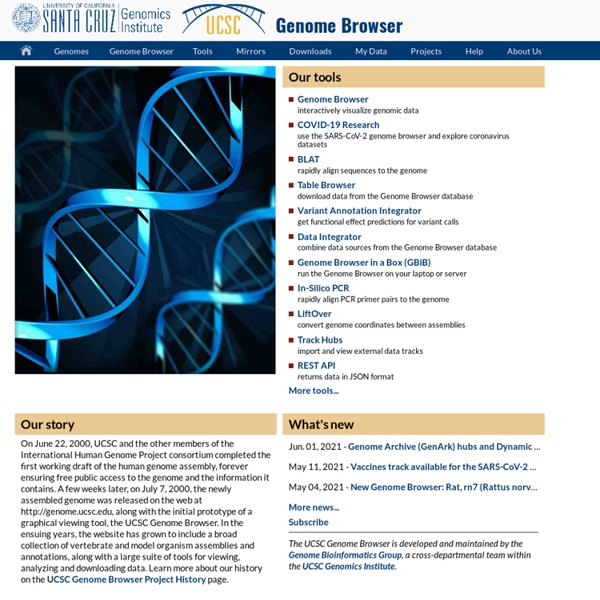PLINK
This page describes some basic file formats, convenience functions and analysis options for rare copy number variant (CNV) data. Support for common copy number polymorphisms (CNPs) is described here. Copy number variants are represented as segments. These segments are essentially represented and analysed in a similar manner to how PLINK handles runs of homozygosity (defined by a start and stop site on a given chromosome).
Search ChIP-qPCR Assay
Find the binding sites of your transcription factor by choosing your transcription factor of interest. If you have a gene of interest, typing its symbol in the second dialog box below will limit your search results. DECODE: DECipherment Of DNA Elements SABiosciences' proprietary database combines our Text Mining Application and data from the UCSC Genome Browser to compile a list of predicted binding sites for over 200 human transcription factors for every gene in the human genome.
Gene Enrichment Profiler
Welcome to the Gene Enrichment Profiler. This database contains expression profiles for ~12,000 genes with NCBI GeneID entry across 126 primary human tissues. Expression profiles were processed to identify tissue specificity which is measured by an enrichment score. High enrichment scores mean higher specificity. The enrichment score is comparable between genes, thus allowing ranking of genes in each tissue profiled. Visit the datasets page to see the profiled tissues and genes most highly enriched in these tissues.
non-B DB
Please note that non-B DB has been updated to Version 2.0 on Wednesday, June 13, 2012 . To learn more about v2.0, please visit FAQ. If you have any questions, please feel free to contact us. DNA exists in many possible conformations that include the A-DNA, B-DNA, and Z-DNA forms; of these, B-DNA is the most common form found in cells. The DNAs that do not fall into a right-handed Watson-Crick double-helix are known as non-B DNAs and comprise cruciform, triplex, slipped (hairpin) structures, tetraplex (G-quadruplex), left-handed Z-DNA, and others. Several recent publications have provided significant evidence that non-B DNA structures may play a role in DNA instability and mutagenesis, leading to both DNA rearrangements and increased mutational rates, which are hallmark of cancer.
The 50 best films of the '90s (1 of 3)
Few talk about the ’90s as a filmmaking renaissance on par with the late ’60s and early ’70s, but for many of the film critics at The A.V. Club, it was the decade when we were coming of age as cinephiles and writers, and we remember it with considerable affection. Those ’70s warhorses like Martin Scorsese and Robert Altman posted some of the strongest work of their careers, and an exciting new generation of filmmakers—Quentin Tarantino, Joel and Ethan Coen, Wong Kar-Wai, Olivier Assayas, David Fincher, and Wes Anderson among them—were staking out territory of their own. Presented over three days—with two 20-film lists, then a separate one for the top 10—our Top 50 survey was conducted in an effort to reflect group consensus and individual passion, with the disclaimer that all such lists have a degree of arbitrariness that can’t be avoided.
ASHG 2010: 1000 Genomes Project Tutorials
ASHG 2010: 1000 Genomes Project Tutorial Videos The 1000 Genomes Project has released the data sets for the pilot projects and for more than 1000 samples for the full-scale project. A tutorial for how to use the data was held at the 2010 American Society of Human Genetics (ASHG) annual convention on November 3. Videos for each of the tutorial sessions are now available. The tutorial describes 1000 Genomes Project data, how to access it and how to use it.
CircuitsDB
A database of MicroRNA / Transcription Factor Regulatory Circuits in Human and Mouse Welcome to Circuits DB, a resource devoted to the identification and analysis of mixed MicroRNA / Transcription Factor Regulatory Circuits in the Human and Mouse genomes. Promoters and 3'-UTRs are thought to control the expression of coding genes mainly in response to transcription factors (TF) and microRNAs. In particular, several methods exist to elucidate TF-related and microRNA-related regulatory networks, but comparable information is lacking to explicitly connect them. This web-site supports a study of a genome-wide transcriptional and post-transcriptional regulatory network integration, in the human and mouse genomes, based on a bioinformatic sequence-analysis work.
BioMart
ENCODE Project at UCSC
Butterfly Wing Anatomy - EnchantedLearning.com
Advertisement. EnchantedLearning.com is a user-supported site. As a bonus, site members have access to a banner-ad-free version of the site, with print-friendly pages.Click here to learn more.
PennCNV
PennCNV: copy number variation detection Welcome! PennCNV is a free software tool for Copy Number Variation (CNV) detection from SNP genotyping arrays. Currently it can handle signal intensity data from Illumina and Affymetrix arrays.
UFGI Bioinformatics
The MAPPER Database contains putative Transcription Factor Binding Sites (TFBSs) located in the upstream sequences of genes from the human, mouse and D.melanogaster genomes. For each transcript, the region scanned extends from 10,000bp upstream of the transcript start to 50bp downstream of the coding sequence start. Therefore, the database contains putative binding sites in the gene promoter and in the initial introns and non-coding exons. Information displayed for each putative binding site includes the transcription factor name, its position (absolute on the chromosome, or relative to the gene), the score of the prediction, and the region of the gene the site belongs to.
Existential & Psychological Movie Recommendations
Film, as with many of the arts, often reflects many existential themes. This page, which was developed following several request for such a list, offers suggestions of movies which reflect existential and psychological themes. The information about the movies is brief to not give away anything which would impact the enjoyment of the movie. See also What is an Existential Movie?




redga grafic TF validati prin ChIP-Seq by denisa.ardevan Sep 13